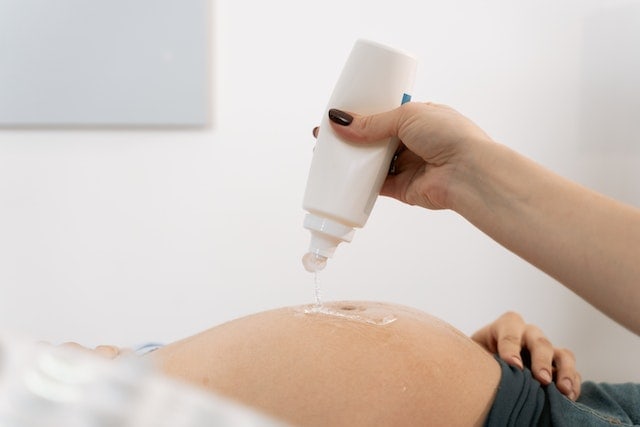Skin tags are small, benign growths that can appear on various parts of the body. They are particularly common during pregnancy, and can often occur on the areola.
While skin tags are generally harmless, they can be unsightly and uncomfortable, causing irritation and even bleeding in some cases. Understanding the causes and treatment options for skin tags during pregnancy is important for women who are experiencing this condition.
Skin tags during pregnancy are caused by a combination of hormonal changes and increased blood flow to the skin. These growths are more common in women who are overweight or have a family history of skin tags.
While they can appear anywhere on the body, they are particularly common in areas where skin rubs against skin, such as the neck, underarms, and groin.
Skin tags on the areola can be especially concerning for women, as they can cause discomfort and self-consciousness.
Key Takeaways:
- Skin tags are common during pregnancy and can occur on various parts of the body, including the areola.
- Hormonal changes and increased blood flow to the skin are the primary causes of skin tags during pregnancy.
- Treatment options for skin tags include removal by a healthcare provider, as well as self-care measures such as keeping the affected area clean and dry.
Understanding Skin Tags During Pregnancy

Skin tags are small, benign skin growths that can occur in various parts of the body, including the areola, during pregnancy. These growths are often harmless and painless, but they can be a source of concern for pregnant women.
Skin tags are more common during pregnancy due to hormonal changes that occur in the body. These changes can cause an increase in the production of growth factors, which can lead to the development of new skin tags.
Pregnant women may also experience other skin changes, such as darkening of the skin around the nipples, known as the areola. This is due to an increase in the production of the hormone melanin, which is responsible for skin pigmentation.
While skin tags are generally harmless, it is important to consult a healthcare provider if you notice any changes in the appearance of the growths or if they become painful or irritated.
In some cases, skin tags may be removed for cosmetic reasons or if they are causing discomfort. However, removal is not always necessary and should be discussed with a healthcare provider.
In summary, skin tags are a common occurrence during pregnancy due to hormonal changes in the body. While they are generally harmless, it is important to monitor them and seek medical advice if necessary.
Causes of Skin Tags in Pregnancy
Skin tags are small growths that can occur on various parts of the body, including the neck, armpits, and breasts. During pregnancy, it is common for women to develop skin tags on their areolas, which are the circular areas around the nipples.
The exact cause of skin tags in pregnancy is not fully understood, but there are several factors that may contribute to their development.
One of the primary causes of skin tags in pregnancy is hormonal changes. As estrogen levels increase during pregnancy, it can cause an overgrowth of skin cells, which can lead to the formation of skin tags.
Additionally, the hormone leptin, which is produced by fat cells, can also contribute to the development of skin tags.
Weight gain is another factor that can increase the likelihood of developing skin tags during pregnancy. As the body gains weight, there is more friction between skin folds, which can lead to the formation of skin tags. This is particularly true in areas where skin rubs against clothing, such as the underarms and thighs.
Other factors that may contribute to the development of skin tags in pregnancy include genetics, blood vessel abnormalities, and certain medical conditions such as diabetes and obesity.
Additionally, the human papillomavirus (HPV) has been linked to the development of skin tags.
It is important to note that skin tags in pregnancy are generally harmless and do not require medical treatment. However, if a skin tag becomes irritated or painful, it may be necessary to seek the advice of a dermatologist.
Skin Tags on Areola and Other Areas
Skin tags are common among pregnant women, and they can appear on various parts of the body, including the areola. Skin tags are small, benign growths that can vary in color, shape, and size. They are typically flesh-colored or slightly darker and can be raised or flat.
Skin tags on the areola are not harmful, but they can be unsightly and cause discomfort. They are more common in women who are pregnant or breastfeeding, as hormonal changes can cause skin tags to develop.
Skin tags can also appear in other areas of the body, such as underarms, eyelids, and other areas where skin rubs against skin.
Skin tags are not contagious, and they do not require treatment unless they are causing discomfort or irritation. However, if a skin tag changes in color, shape, or size, it is important to have it checked by a healthcare provider to rule out any underlying medical conditions.
There are several ways to remove skin tags, including surgical excision, freezing, and cauterization. However, it is important to consult with a healthcare provider before attempting to remove a skin tag at home, as improper removal can lead to scarring and infection.
In conclusion, skin tags on the areola and other areas of the body are common and usually harmless. They can be removed if they are causing discomfort or irritation, but it is important to consult with a healthcare provider before attempting to remove them at home.
Difference Between Skin Tags and Other Skin Changes

During pregnancy, women may experience various changes in their bodies, including changes in their skin. Skin tags are one of the most common skin changes that occur during pregnancy.
However, it is essential to distinguish skin tags from other skin changes.
Skin tags are small, soft, and harmless growths that usually appear on the neck, armpits, groin, and under the breasts. They are caused by the rubbing of skin against skin or clothing. Skin tags are not contagious and do not pose any health risks.
On the other hand, warts are caused by a viral infection and can be contagious. They usually appear on the hands and feet, but they can also occur on other parts of the body. Warts can be removed with treatment, but they can also disappear on their own.
Moles, on the other hand, are usually present at birth or appear during childhood. They are usually harmless, but some moles can develop into skin cancer.
It is essential to monitor any changes in the size, shape, or color of moles and to seek medical attention if necessary.
Stretch marks are another common skin change that occurs during pregnancy. They occur when the skin is stretched, and the collagen and elastin fibers are damaged. Stretch marks usually appear on the abdomen, breasts, hips, and thighs. They do not pose any health risks but can be unsightly.
Hyperpigmentation, melasma, and acne are other skin changes that can occur during pregnancy. Hyperpigmentation is the darkening of the skin, while melasma is the appearance of brown patches on the face. Acne can also occur due to hormonal changes during pregnancy.
Varicose veins are another common skin change that occurs during pregnancy. They are caused by the increased pressure on the veins in the legs due to the weight of the uterus.
Support stockings and regular exercise can help alleviate the discomfort caused by varicose veins.
Progesterone, a hormone produced during pregnancy, can cause the skin to become dry and itchy. Using a moisturizer can help alleviate the dryness and itchiness.
In conclusion, skin tags are a common skin change that occurs during pregnancy. However, it is essential to distinguish skin tags from other skin changes, such as warts, moles, stretch marks, hyperpigmentation, melasma, acne, and varicose veins.
Seeking medical attention if necessary is crucial to ensure the health and well-being of the mother and the baby.
Removal and Treatment of Skin Tags
Skin tags on the areola during pregnancy are usually harmless, but they can cause discomfort or even infection if they are irritated. Some women may also experience skin tags due to genetics, sex hormones, insulin sensitivity, or other factors.
Skin tag removal can be done for medical or cosmetic reasons. There are several treatments available, including excision, freezing, cauterization, snipping, cryosurgery, and more. However, some of these methods may cause bleeding or other risks.
Medical remedies, such as tea tree oil, garlic, apple cider vinegar, or cryotherapy, may also be used to treat skin tags. However, it is important to consult a healthcare provider before trying any of these methods, especially during pregnancy or the postpartum period.
In general, skin tag removal during pregnancy should be avoided unless it is necessary for medical reasons. If a woman experiences discomfort or infection due to skin tags, her healthcare provider may recommend a safe and effective treatment option.
Skin tag removal for cosmetic reasons can be done after pregnancy, preferably in the third trimester or later.
Prevention and Care for Skin Tags

Skin tags on the areola during pregnancy can be concerning for some women. While they are usually harmless, they can be uncomfortable or unsightly.
The following tips can help prevent and care for skin tags on the areola during pregnancy:
Prevention
- Keep the area clean and dry. Moisture and friction can cause skin tags to form, so it’s important to keep the area clean and dry. Use a gentle soap and warm water to clean the area, and pat it dry with a clean towel.
- Wear comfortable clothing. Tight or restrictive clothing can cause friction and irritation, which can lead to skin tags. Opt for loose-fitting clothing made from breathable fabrics like cotton or bamboo.
- Maintain a healthy weight. Being overweight or obese can increase the likelihood of developing skin tags. Maintaining a healthy weight through diet and exercise can help prevent them.
Care
- Leave them alone. Skin tags are usually harmless and don’t require treatment. Trying to remove them at home can be painful and may lead to infection.
- Consult a healthcare provider. If a skin tag is causing discomfort or is located in a sensitive area, a healthcare provider may be able to remove it safely and painlessly.
- Manage symptoms. If a skin tag is causing discomfort, over-the-counter pain relievers like acetaminophen or ibuprofen can help manage symptoms.
Overall, skin tags on the areola during pregnancy are usually harmless and don’t require treatment. However, taking steps to prevent them and caring for them if they do occur can help manage symptoms and prevent complications.
Related posts:
Frequently Asked Questions
Yes, skin tags on the areola are quite common during pregnancy. They are harmless and usually go away on their own after delivery.
It is not recommended to remove skin tags on the nipples during pregnancy as it may cause bleeding and infection. It is best to wait until after delivery to have them removed.
The exact cause of skin tags on the areola during pregnancy is not known. However, hormonal changes and increased blood flow to the area may contribute to their development.
Yes, skin tags on the anus are also common during pregnancy. They are caused by the same hormonal changes and increased blood flow that cause skin tags on the areola.
Yes, skin tags from pregnancy usually go away on their own after delivery. However, if they are causing discomfort or are unsightly, they can be removed by a healthcare provider.
It is not recommended to remove skin tags during pregnancy unless they are causing discomfort or are unsightly. If removal is necessary, it should be done by a healthcare provider in a safe and sterile environment.

Iesha is a loving mother of 2 beautiful children. She’s an active parent who enjoys indoor and outdoor adventures with her family. Her mission is to share practical and realistic parenting advice to help the parenting community becoming stronger.
